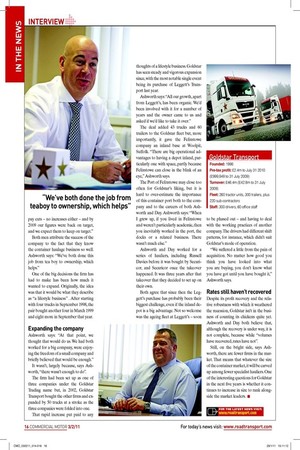The sky’s the limit
Page 12

Page 13

Page 14

If you've noticed an error in this article please click here to report it so we can fix it.
Six months ago, Goldstar Transport bought Leggett’s Transport. Not bad for a company that started life with two men, a phone and a briefcase 13 years ago
Words: David Harris / Images: Nigel Spreadbury
FOR A PAIR OF self-confessed “modern-day barrow boys” , MD Matthew Ashworth and director Simon Day have made a success of Felixstowe container specialist Goldstar Transport. The pair set up the company in 1998 with just four trucks and now run a leet of 260 tractor units, 300 trailers and 220 dedicated contractors.
They have 300 drivers and 60 ofice staff to keep this leet on the road. But perhaps the irm’s most notable idiosyncrasy is that it has no inancial director or accountant.
It might run contrary to just about any commercial advice you’ve ever heard, and not many irms of this size would choose to run without a inance specialist on the books, but Ashworth and Day have never seen the need.
Ever since they set up “with a pink phone and a briefcase” , the two have preferred looking after their own inances.
Ashworth says: “We know the business, we know the numbers and we know our proit and losses every week.
“If things went badly, I suppose we might need some outside help, but so far we haven’t.”
Recession bites
That doesn’t mean that Goldstar was unaffected by the recession. This was most notably shown in the pre-tax proit, which was £2.9m in the year to July 2008, but fell below £1m for the year to July 2009. It has recovered well, to £2.4m in the year to July 2010.
While that recession-driven fall in proit was far from rosy, it was less disastrous than that faced by many hauliers. Importantly, Ashworth and Day were pleased that nobody lost their job. Ashworth says: “We are proud of that. Nobody was laid off, there were no pay cuts – no increases either – and by 2009 our igures were back on target, and we expect them to keep on target.” Both men attribute the success of the company to the fact that they know the container haulage business so well. Ashworth says: “We’ve both done this job from tea boy to ownership, which helps.” One of the big decisions the irm has had to make has been how much it wanted to expand. Originally, the idea was that it would be what they describe as “a lifestyle business” . After starting with four trucks in September 1998, the pair bought another four in March 1999 and eight more in September that year.
Expanding the company
Ashworth says: “At that point, we thought that would do us. We had both worked for a big company, were enjoying the freedom of a small company and briely believed that would be enough.” It wasn’t, largely because, says Ashworth, “there wasn’t enough to do” .
The irm had been set up as one of three companies under the Goldstar Trading name but, in 2002, Goldstar Transport bought the other irms and expanded by 50 trucks at a stroke as the three companies were folded into one.
That rapid increase put paid to any thoughts of a lifestyle business. Goldstar has seen steady and vigorous expansion since, with the most notable single event being its purchase of Leggett’s Transport last year.
Ashworth says: “All our growth, apart from Leggett’s, has been organic. We’d been involved with it for a number of years and the owner came to us and asked if we’d like to take it over.” The deal added 43 trucks and 60 trailers to the Goldstar leet but, more importantly, it gave the Felixstowe company an inland base at Woolpit, Suffolk. “There are big operational advantages to having a depot inland, particularly one with space, partly because Felixstowe can close in the blink of an eye,” Ashworth says.
The Port of Felixstowe may close too often for Goldstar’s liking, but it is hard to over-estimate the importance of this container port both to the company and to the careers of both Ashworth and Day. Ashworth says: “When I grew up, if you lived in Felixstowe and weren’t particularly academic, then you inevitably worked in the port, the docks or a related business. There wasn’t much else.” Ashworth and Day worked for a series of hauliers, including Russell Davies before it was bought by Securicor, and Securicor once the takeover happened. It was three years after that takeover that they decided to set up on their own.
Both agree that since then the Leggett’s purchase has probably been their biggest challenge, even if the inland depot is a big advantage. Not so welcome was the ageing leet at Leggett’s – soon to be phased out – and having to deal with the working practices of another company. The drivers had different shift patterns, for instance, which didn’t suit Goldstar’s mode of operation.
“We suffered a little from the pain of acquisition. No matter how good you think you have looked into what you are buying, you don’t know what you have got until you have bought it,” Ashworth says.
Rates still haven’t recovered
Despite its proit recovery and the relative robustness with which it weathered the recession, Goldstar isn’t in the business of counting its chickens quite yet. Ashworth and Day both believe that, although the recovery is under way, it is not complete, because while “volumes have recovered, rates have not” .
Still, on the bright side, says Ashworth, there are fewer irms in the market. That means that whatever the size of the container market, it will be carved up among fewer specialist hauliers. One of the interesting questions for Goldstar in the next ive years is whether it continues to increase in size to rank alongside the market leaders. ■













































